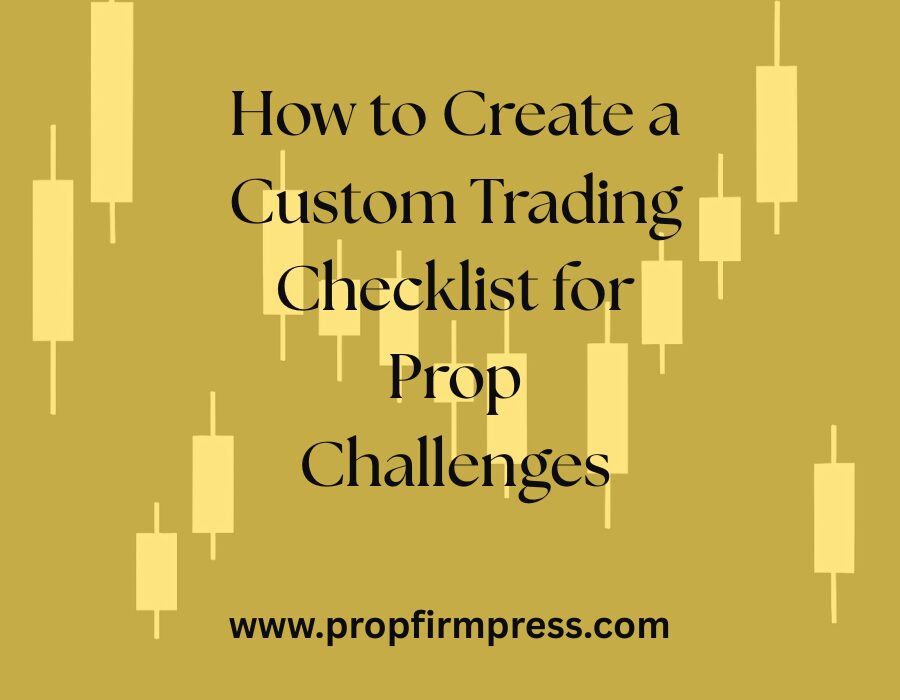Your Checklist Is Your Trading Anchor
Prop firm challenges test more than your strategy—they test your ability to execute consistently. A well-crafted trading checklist helps eliminate emotional decisions, enforce discipline, and keep your actions aligned with the evaluation’s rules. It’s one of the most powerful—and most overlooked—tools a trader can use to increase funded success rates.
Why a Checklist Outperforms Memory
Professional pilots, surgeons, and engineers use checklists—not because they’re amateurs, but because they understand the cost of human error. Traders are no different. When markets move fast, emotions surge. A checklist brings structure to that chaos. It provides a simple reference point to fall back on during high-stakes decisions.
What to Include in Your Custom Checklist
Your trading checklist should reflect the specific rules of your prop firm challenge, your strategy, and your emotional tendencies. Core elements include:
- Account Rules: Daily loss limit, max drawdown, news restrictions, trading hours
- Strategy Filters: Valid setups only (e.g., trend continuation, reversal, breakout)
- Risk Management: Maximum % risk per trade, position sizing, stop loss pre-set
- Execution Triggers: Confirmed entry criteria met (price action, volume, indicator confluence)
- Pre/Post-Routine: Morning prep checklist, end-of-day journaling task
Step-by-Step: Building a Checklist That Works
Step 1: Start With Prop Firm Parameters
Go through your chosen firm’s rulebook. Write down the absolute must-follow rules that would cause a failure or reset:
- Example: Max daily loss = $1,000
- Trailing drawdown resets on high watermark close
- 5 minimum trading days
- No trading 1 minute before/after major news releases
These form your foundational checklist items—non-negotiable rules to guide every session.
Step 2: Add Strategy Requirements
Once the rules are listed, identify your key strategy filters. What must be true before you enter a trade? For example:
- Trend is aligned on 1HR and 5MIN charts
- Price at supply/demand zone
- Volume confirmation or divergence present
- Risk-reward minimum of 2:1
These prevent emotional entries and keep your trading systematic.
Step 3: Integrate Pre-Trade Routines
Checklist items for pre-market or pre-trade setup might include:
- ✅ Reviewed news calendar (e.g., forexfactory or PropFirmPress.com)
- ✅ Completed daily affirmation
- ✅ Reviewed overnight levels / key zones
- ✅ Logged market sentiment
This primes your focus before execution begins.
Step 4: Add Post-Trade Review Prompts
At the end of the day, reviewing your trades against your checklist is critical. Add:
- ✅ Did I follow all prop firm rules?
- ✅ Was each entry aligned with my strategy?
- ✅ Did I follow my risk parameters?
- ✅ Journaled trade with screenshot & notes
Step 5: Customize for Your Emotional Triggers
If you know you overtrade or revenge trade, create rule-based friction:
- ✅ No trades after 2 losses in a row
- ✅ Only 3 trades max per session
- ✅ Use timer between trades (5–10 minutes)
Use the checklist to protect yourself from yourself.
Step 6: Use a Visual Format You’ll Actually Follow
Create your checklist in one of the following formats:
- Printable Sheet: Laminate and mark off with dry erase
- Digital Notepad: Keep open next to your charting platform
- Trading Journal Template: Use a Prop Firm Press checklist journal
Make it frictionless. A checklist you don’t use is useless.
Step 7: Keep It Short and Actionable
No more than 15 items total. Each item should be a “yes” or “no” question. Avoid complexity. Example:
- ✅ Risk per trade = 1% or less?
- ✅ Entry based on trade plan?
- ✅ Stop-loss set before entry?
- ✅ Max loss per day respected?
This binary format helps you stay accountable without second guessing.
Step 8: Use Your Checklist Before Every Trade
Use it as a pre-launch protocol. Literally pause before pressing buy/sell and confirm every box is checked. This habit separates amateurs from professionals.
Step 9: Adapt It as You Evolve
Checklists are living documents. Update yours every 2–4 weeks based on journal reviews. If you notice new mistakes, add a checklist item to catch it. If something becomes second nature, you can remove it.
Checklist = Confidence Under Pressure
Traders who pass prop firm evaluations repeatedly almost always have structured systems. Your checklist becomes the bridge between your trading knowledge and your live execution. It removes doubt, adds consistency, and acts as a barrier between you and avoidable mistakes.
If you’re serious about passing your next challenge—start building your checklist today and let it be your anchor in every trade.
